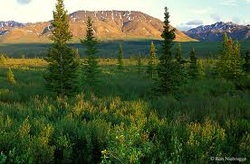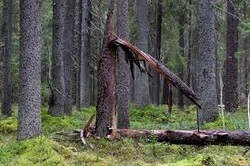Human Impact on Taiga Biome

The taiga is a biome that is consistently under threat. Large-scale clear cutting and plantation forestry destroys the biodiversity of the land. Introduction of exotic tree species wipe out the native species due to their human cultivation and usage of pesticides and herbicides. Industrial forestry has destroyed a majority of the boreal forest because the wood is important in the production of pulp and paper. In addition to the forestry, humans have also threatened the Taiga with oil and gas exploration, road building, forest fires, and the obvious global warming caused climate change. The animals of the taiga are often hunted and trapped for their precious fur and thus has led to large scale population reductions. Humans have also ruined the water supply of the Taiga by introducing hydroelectric power which has also lead to mercury poisoning for many fish. Overall the Taiga has been destroyed equal to that of the rain forest.
Humans need to worry about the destruction of the Taiga because we are destroying the animals and tree diversity by converting trees into tissues and paper. In order to save the Taiga, we must reduct our use of paper and wood products. Global warming has led to the destruction of the cold environment that runs the Taiga ecosystem. Because of the warming, more tropical animals are able to move into the colder Taiga climate and are slowly over running the area.
Humans are helping the taiga in many ways also. Through conservation efforts we are able to save many trees and animal life. Some theorists also claim that the introduction of global warming is actually protecting the Taiga from invasive insects which are destroying the ecosystem and tree populations. On a general basis, human influence has not been positive in the area since we use it for many of its resources.
Humans need to worry about the destruction of the Taiga because we are destroying the animals and tree diversity by converting trees into tissues and paper. In order to save the Taiga, we must reduct our use of paper and wood products. Global warming has led to the destruction of the cold environment that runs the Taiga ecosystem. Because of the warming, more tropical animals are able to move into the colder Taiga climate and are slowly over running the area.
Humans are helping the taiga in many ways also. Through conservation efforts we are able to save many trees and animal life. Some theorists also claim that the introduction of global warming is actually protecting the Taiga from invasive insects which are destroying the ecosystem and tree populations. On a general basis, human influence has not been positive in the area since we use it for many of its resources.
Scientific Studies
There are many scientific studies that have taken place in the taiga. The recent study done in 2008 by William Pruitt shows the influence of the humans in Taiga. As humans have continued to settle in the Taiga biome, they have introduced buildings and thus, have cleared land for roads and power lines. Inadvertently, this clearing of land has allowed the White tailed deer to prosper and grow. Because humans continuously clear the land, they have been keeping the land in the area in the pioneer stage of succession. These pioneer species allow the white tailed deer to thrive with the new source of food and has lead to an increase in wolves in the area as well. Despite the human clearings maintaining both of these populations, scientists are worried that the increased congregation of the deer will allow a specific parasite that infects the deer to spread through the populations quicker and eventually demolish the deer population in the area. This is lead to the destruction of the wolf population and will hurt the ecosystem severely. This shows in the impact that human arrival has had on the Taiga biome.
The research paper can be found at -> http://www.wilds.mb.ca/taiga/mnsbulletin2008march.pdf
The research paper can be found at -> http://www.wilds.mb.ca/taiga/mnsbulletin2008march.pdf
Taiga Conservation Laws

Deforestation in the Taiga biome in Russia has become a huge problem that the Russian government has to face. Because of the massive amounts of trees being cut down to turn into paper, the Ministry of Forestry set out a new law to help keep the forestry companies to cut more sustainable. Although the Ministry of Forestry sets laws and regulations as well as patrolling the forests to ensure good forest practices, illegal logging is still present. The main regulatory agencies (divisions with the Ministry of Natural Resources, the Forest Service, and the Hunting Administration) also need the right to arrest loggers and carry firearms. The Ministry of Internal Affairs, whose officials have this right, has established special task forces targeting illegal logging and trade; these task forces, however, so far have struggled to work effectively with other regulatory agencies. This law has allowed a lot of the trees in this biome to be saved from the excessive loggers found in Russia.
